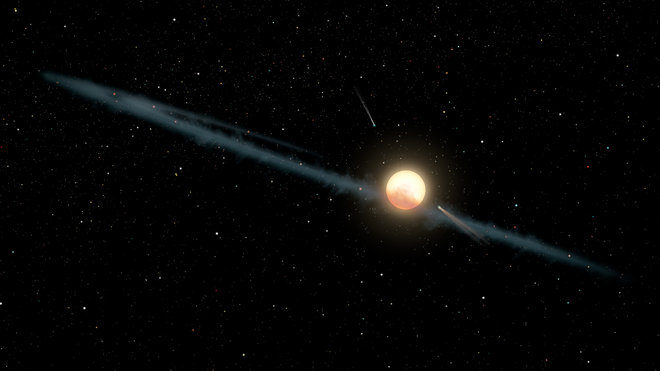
By now, though, researchers have figured out that it's not an alien megastructure that is causing the dimming; it's just dust. Still, astronomer Tabetha Boyajian of Louisiana State University and colleagues are keeping a close eye on the far-off star, trying to figure out what the dust is and where it came from. On March 16, the brightness of the star started dipping, Boyajian and her colleagues reported on their blog. The dip in brightness was the largest observed dip in the star since 2013, Boyajian wrote.
As of March 22, the star's brightness was increasing rapidly and was almost back to normal.
Tabby's star
The vagaries of KIC 8462852, the star better known as "Tabby's star" in honor of Boyajian, have been the subject of scientific sleuthing for years. In 2015, researchers led by Boyajian reported that the Kepler space telescope had captured a completely new phenomenon at Tabby's star. At irregular intervals and for odd lengths of time, the light from the star would dim by as much as 22 percent. Nothing could really explain it. One theory was that the star might be surrounded by an alien megastructure such as a Dyson sphere, an orbiting array of solar panels designed by some intelligent life-form.
But a January 2018 study by Boyajian and her colleagues debunked that notion. They studied the spectrum of light coming from the star and found that different wavelengths were blocked by the mystery occlusion at different levels of brightness. What this means is that whatever passes between the star and Earth is translucent, not opaque like a megastructure would be. The best explanation for what might be causing the dimming, the researchers found, was very fine space dust.
Boyajian and her colleagues have been researching the star with funds donated via Kickstarter. Among the remaining questions: How is the dust orbiting the star - in clouds, or perhaps in a ring? And where did the dust originate?
Mystery dust
Boyajian and her team have a few ideas about what the dust is. In a 2016 paper, they suggested that it might come from collisions between larger orbiting objects in an asteroid belt; however, that explanation was hard to reconcile, they warned, because the asteroid-belt scenario should produce other detectable phenomena, like brightness dips of different depths and lengths representing collisions between objects of different sizes.
Another possibility, they wrote, is that the dust could be from a single, giant impact, like the one that broke the moon away from Earth. This theory doesn't fit well with the pattern of dimming seen, though, particularly small dips in brightness without a regular reoccurrence interval matching the larger dips. A third option might be minute planetary bodies that are themselves surrounded by dust. That's an attractive theory because the small asteroids or rocky objects would keep the dust from dispersing, but like the giant-impact theory, it doesn't fit the observed dimming patterns very well, the researchers wrote.
The final theory is that the dust is orbiting in a highly irregular, elliptical orbit, like a comet; in fact, the researchers wrote, it might even be a broken-up comet. This hypothesis matches the star's dimming patterns if you assume that whatever broke up the comet hit it with enough force to "kick" its tail forward. If the particles in the tail are large enough, they could maintain that backward-comet orientation even against the electromagnetic forces of the star, the researchers wrote.
The latest dimming event started with a slow decline and ended with a rapid increase in brightness, Boyajian and her team wrote on their blog. Dust from a backward comet tail and then larger chunks from the broken-up body would explain that uneven pattern.



Reader Comments